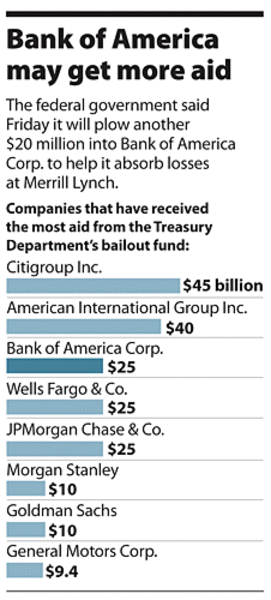Why banks still teeter, after $232 billion in aid
Loading...
| New York
The troubled banking system continues to need help from Uncle Sam, even after a recent infusion of $232 billion, compliments of the US Treasury.
The main reason banks will likely get another taxpayer assist of, say, $200 billion: Their own balance sheets remain fragile, and almost no one else will give them new capital.
Banks sought billions in taxpayer assistance last year because of their losses in the mortgage and housing markets. Now, they are getting pinched by the recession as consumers miss payments on credit-card bills, developers default on loans for new office towers, and a rising number of companies go bankrupt.
"We are estimating they will need another $100 billion to $200 billion to offset their write-offs and keep their capital ratios in line," says Brian Bethune, chief US financial economist at IHS/Global Insight in Lexington, Mass., an economic forecasting and analysis firm. "After the problem in housing two years ago, we are getting these compounding effects from the recession."
The banks' continued need for capital resonated in Washington last week, with the Senate deciding it would not block the release of $350 billion more for the Troubled Asset Relief Program, even though many questions have been raised about how wisely the US Treasury used the first $350 billion in TARP funds that Congress authorized. The House is expected to take up the matter this week, but any vote would be symbolic because it takes both houses of Congress to block dispersal of the funds.
The banks remain in such precarious positions, some analysts worry, that even those additional billions may not be enough to put them on firm footing. "My guess is there will be multiple TARPs before this thing is over," says Doug Roberts, director of research at Channel Capital Research in Shrewsbury, N.J. "The other alternative is the insolvency of the banking system."
Continued weakness in the banking sector is prompting some talk that banks are undergoing a de facto nationalization, because the federal government is the main source of new capital.
"I don't believe the banks' survival is any longer a matter of market forces. It's up to the politicians and the impact on the economy," says Donald Thomas, senior analyst at Gradient Analytics in Scottsdale, Ariz.
Their latest problem is huge losses stemming from the economic downturn. The latest available data show the number of businesses filing for bankruptcy soared 61 percent in the third quarter over the same period in 2007, the American Bankruptcy Institute reports. More recently, some large companies, such as Nortel, the telecom company, and Circuit City, the big box retailer, filed for bankruptcy.
Bank executives say credit-card losses are rising and in some banks now represent 5 to 7 percent of their portfolios.
"Credit-card losses are approaching or above historical levels," says Mr. Thomas.
In the past, banks were able to take losses and keep functioning without government aid. But bankers, normally conservative, took such great risk in the mortgage markets that most banks do not have sufficient reserves going into the recession, says Mr. Thomas. "The banks are now hobbled."
Some analysts are concerned about the economic effect of continued bad news, referring to it as a negative feedback loop.
"As more people stop paying on their credit cards, it puts more bank assets in jeopardy, which results in less lending, which in turn contributes to the ongoing financial crisis," says Martin Baily, a senior fellow at the Brookings Institution in Washington.
Banks' need for new capital was apparent again last week, when the Treasury said it would invest $20 billion in Bank of America – on the same day the company reported a $1.8 billion loss for the fourth quarter of 2008. Some of the new funds will help the bank swallow Merrill Lynch & Co., which reported a $15 billion fourth-quarter loss and was acquired by BofA Jan. 1.
At the same time, the government is trying to shore up Citigroup's finances. On Friday, the Treasury said it will guarantee $301 billion in Citigroup assets, supplying the missing number in an agreement first announced in November. Citi reported a loss of $8.2 billion in the fourth quarter, and its stock continued to fall.
"What is important is that it shifts the results of historic bad decisions on the part of Citi risk management onto us taxpayers," says Thomas of Gradient.
The scramble to plow money into Citi reflects the government's position that such large banks cannot be allowed to fail. "The repercussions would be too great," says Mr. Baily. "But they are trying to get rid of parts of the company that are potentially profitable."
Citi said last week it would move its Smith Barney brokerage business into a joint venture with Morgan Stanley. Executives claim the move would net the bank $5.8 billion. By year's end, Citibank will have shed about 30 percent of its assets, analysts say.
"It looks like the future for the bank is diluted ownership, elimination of the dividend, and a lengthy restructuring of the company to only a fraction of its old self," says Fred Dickson, chief investment strategist at D.A. Davidson & Co. in Lake Oswego, Ore. "We will have to see how the government manages the process."
Mr. Bethune says the US banking sector is in a process of further consolidation. Today, the 10 biggest banks have 60 percent to 70 percent of the nation's financial assets, he says. "In the future they will have perhaps 80 percent of the assets," he says. "There will be increased concentration, less competition, and more fees."





